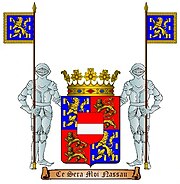
Back Йохан IV (Насау) Bulgarian Johan 4. af Nassau-Dillenburg Danish Johann IV. (Nassau) German Ιωάννης Δ΄ του Νάσσαου-Ντίλενμπουργκ Greek Jean IV de Nassau-Dillenbourg French Jan IV van Nassau Dutch Иоганн IV (граф Нассау) Russian 約翰四世 (拿騷) Chinese
John IV, Count of Nassau-Siegen | |
|---|---|
 Count John IV of Nassau-Siegen, detail of the epitaph in the Grote Kerk in Breda. Photo: Paul M.R. Maeyaert, 2011. | |
| Count of Nassau-Siegen Count of Vianden Count of Diez Lord of Breda | |
| Coat of arms |  |
| Reign | 1442–1475 |
| Predecessor | Engelbert I |
| Successor |
|
| Full name | John IV, Count of Nassau-Siegen |
| Native name | Johann IV. Graf von Nassau-Siegen |
| Born | Johann Graf zu Nassau, Vianden und Diez, Herr zu Breda 1 August 1410 Breda Castle |
| Died | 3 February 1475 (aged 64) Dillenburg |
| Buried | Grote Kerk, Breda |
| Noble family | House of Nassau-Siegen |
| Spouse(s) | Mary of Looz-Heinsberg |
| Issue Detail | |
| Father | Engelbert I of Nassau-Siegen |
| Mother | Joanne of Polanen |
Count John IV of Nassau-Siegen[note 1] (1 August 1410 – 3 February 1475), German: Johann IV. Graf von Nassau-Siegen, official titles: Graf zu Nassau, Vianden und Diez, Herr zu Breda, was since 1442 Count of Nassau-Siegen[note 2] (a part of the County of Nassau), of Vianden and of half Diez, and Lord of Breda and of the Lek. He descended from the Ottonian Line of the House of Nassau.
Since the death of his father, John owned many fiefs in the Netherlands, which he managed to expand.[1] Through his marriage he obtained that many fiefs in the Duchy of Jülich, that he possessed 1⁄4 of that duchy.[2][3] John was a loyal servant of the Dukes of Burgundy in the Netherlands, who was still called up for military service even when he was well into his fifties, but he was not one of the closest noble advisors.[4] John can best be characterised as a wealthy nobleman who faithfully fought in the campaigns for which he was called up; he was not known for spectacular deeds or revolutionary ideas. The campaigns he took part in are therefore more typical of the politics of the Dukes of Burgundy than of his own preferences and interests.[5] For the administration of justice, the County of Nassau-Siegen had a Schultheiß in most of the districts. The oldest preserved ordinance for the Schultheiß of the Dillenburg district is from John's reign.[6] A not inconsiderable source of income for the Counts of Nassau-Siegen has always been the iron toll. A charter from John's reign concerning the tariffs lists the individual taxes in detail.[7]
Cite error: There are <ref group=note> tags on this page, but the references will not show without a {{reflist|group=note}} template (see the help page).
© MMXXIII Rich X Search. We shall prevail. All rights reserved. Rich X Search